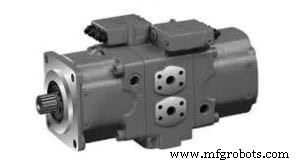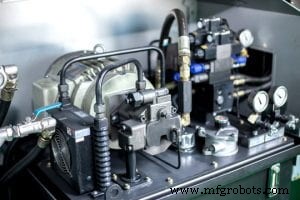O que determina a velocidade de um motor hidráulico
Quando você deseja mover algo com um motor hidráulico, precisa saber duas coisas:a velocidade do fluido (em metros por segundo) e a velocidade do motor (em metros por segundo). Neste artigo, vamos nos concentrar na velocidade do motor e ver como isso afeta a velocidade do fluido.
Motor elétrico
Os motores elétricos funcionam segundo o princípio da indução eletromagnética. Um motor elétrico rotativo é composto de vários eletroímãs, um para cada pólo. Quando uma corrente elétrica passa pelos eletroímãs, eles ficam magnetizados e giram em torno de seus próprios eixos em oposição um ao outro. Isso cria uma força rotacional que pode ser aproveitada para alimentar um motor elétrico. A velocidade de um motor é determinada pela quantidade de corrente que ele pode transportar e pelo tamanho dos eletroímãs.

Motor hidráulico
Bomba de óleo ou prato oscilante de óleo
Há muito debate sobre o que determina a velocidade de um motor hidráulico. Algumas pessoas dizem que a bomba de óleo determina a velocidade, enquanto outras dizem que a placa de respingo de óleo. Ambas as teorias têm algumas evidências para apoiá-las, mas nenhuma delas é definitivamente correta.
A teoria da bomba de óleo é baseada no fato de que uma RPM mais alta exige um fluxo maior de óleo através da bomba. Isso, por sua vez, significa que a bomba trabalhará mais e, portanto, o motor funcionará mais rápido.
No entanto, existem vários outros fatores que também podem afetar a velocidade de um motor hidráulico. Por exemplo, se houver detritos nas linhas de óleo ou se os motores estiverem danificados, eles não funcionarão com a mesma eficiência e isso os tornará mais lentos. Além disso, a temperatura também pode afetar a velocidade de funcionamento de um motor – quanto mais frio, mais lento ele irá.
Em última análise, é impossível determinar exatamente a velocidade de um motor hidráulico sem examiná-lo pessoalmente. No entanto, ao entender como vários fatores podem afetar sua velocidade, você pode garantir que ele opere com o melhor desempenho possível.
A velocidade de um motor hidráulico
Um motor hidráulico é tipicamente mais rápido do que um motor elétrico porque o fluido hidráulico pode se mover mais rapidamente. Além disso, um motor hidráulico não precisa girar tantas vezes para obter o mesmo resultado de um motor elétrico.
No entanto, um motor hidráulico também pode ser menos potente do que um motor elétrico. Isso ocorre porque um motor hidráulico não tem a mesma potência que um motor elétrico para criar torque.
Um motor hidráulico funciona usando fluido pressurizado para girar um eixo. Este eixo pode então ser usado para mover um objeto ou executar tarefas.
O fluido pressurizado pode vir de um reservatório ou pode ser fornecido pelo motor. O reservatório é normalmente preenchido com óleo, água ou algum outro tipo de fluido.
Quando o motor hidráulico é acionado, o fluido pressurizado é forçado para dentro do motor. Isso faz com que o motor gire e crie torque. O torque faz com que o eixo gire e mova o objeto ou execute a tarefa.
Compressão do Petróleo
A velocidade de um motor hidráulico é determinada pela quantidade de compressão que o óleo pode suportar antes de se romper. Quanto maior a compressão, mais rápido o motor irá operar.
Oil compression is measured in psi (pounds per square inch). The higher the psi, the more pressure the oil can withstand before it ruptures.
The maximum oil compression that a hydraulic motor can withstand is around 3000 psi.
If the oil reaches a certain psi level, it can rupture. This can happen suddenly, causing the motor to stop abruptly. Or it can happen over time, with the oil gradually breaking down and becoming unable to withstand the pressure.
Either way, rupture of the oil can be dangerous and lead to a loss of engine power. So it’s important to keep an eye on your oil pressure and make sure it stays within safe limits.
The Output Torque of the Motor
When you buy a motor, it’s important to know the output torque. Output torque is what allows the motor to do its job, and it’s measured in inch-pounds. The higher the output torque, the faster the motor can move objects.
There are a few things that affect output torque. One is the size of the motor. Larger motors have more output torque than smaller motors. Another factor is how quickly the motor can turn. A fast motor has more output torque than a slow motor.
The final factor that affects output torque is the type of fluid inside the motor. Fluids with low viscosity (a thick liquid) have more output torque than fluids with high viscosity (a thin liquid). This is because a low viscosity fluid can flow through a smaller diameter pipe faster than a high viscosity fluid can.
hydraulic motor displacement
A hydraulic motor can be thought of as a piston in a cylinder. The piston is connected to a rotating shaft, and the cylinder is filled with pressurized fluid. The pressure in the cylinder drives the piston, which in turn rotates the shaft.
The size of the piston determines how fast the motor will spin. A small piston will move around quickly, while a large piston will move more slowly. The speed of the motor also depends on how much fluid is inside the cylinder and how tightly the piston is connected to the shaft.
pressure of the oil in the system
The speed of a hydraulic motor is determined by the pressure of the oil in the system. The higher the pressure, the faster the motor will run.
The amount of pressure needed to run a hydraulic motor depends on the type of motor and the size of the system. Typical pressures for various types of motors can be found on the manufacturer’s website. For systems up to 10,000 lb (4,500 kg), a pressure of 40 psi (275 kPa) is typically used. Systems larger than 10,000 lb (4,500 kg) may require higher pressures, such as 50 psi (340 kPa).
esistance to the load being moved
hydraulic motors are typically rated by the number of pounds of pressure that their cylinders can produce. The higher the pressure, the faster the motor will move the load. However, there are other factors that also play a role in how quickly a motor moves a load, such as shaft size and design, number of gears, and motor construction materials.

hydraulic motor
Conclusão
In this article, we will explore the different factors that determine the speed of a hydraulic motor. We will start by looking at the flow rate and pressure drop in a hydraulic system. We will then look at the power input and output of a hydraulic motor, and finally discuss how these factors affect the speed of a hydraulic motor. Hopefully, this article has helped you better understand how to calculate the speed of a hydraulic motor.
Equipamento industrial
- Enrolamentos do motor:quais são as diferenças?
- Motor CC x CA:qual é a diferença?
- O que é a indústria de tintas?
- O que é cal hidráulica?
- O que é uma talha hidráulica?
- Que tipo de motor hidráulico é mais eficiente?
- Como você controla a velocidade de um motor hidráulico?
- O que determina a velocidade de um motor hidráulico?
- Quais são as 2 classificações de bombas hidráulicas?
- Qual é a bomba hidráulica mais eficiente?



